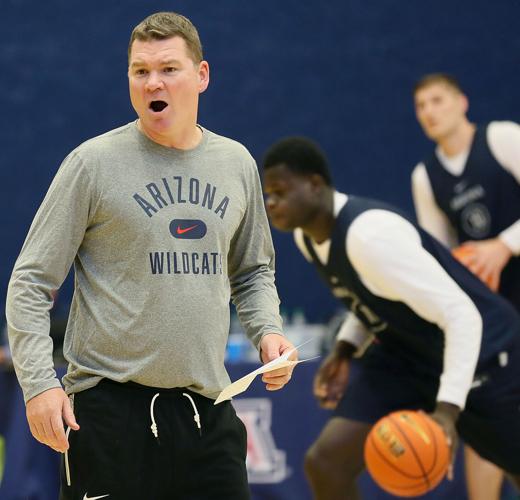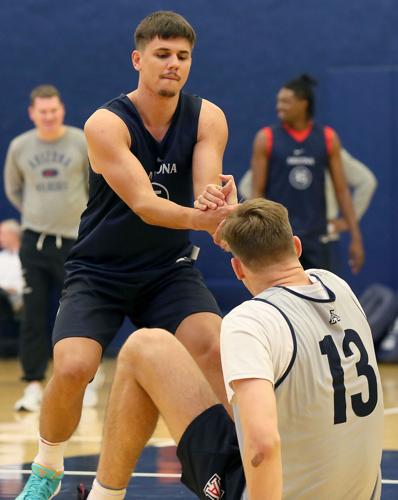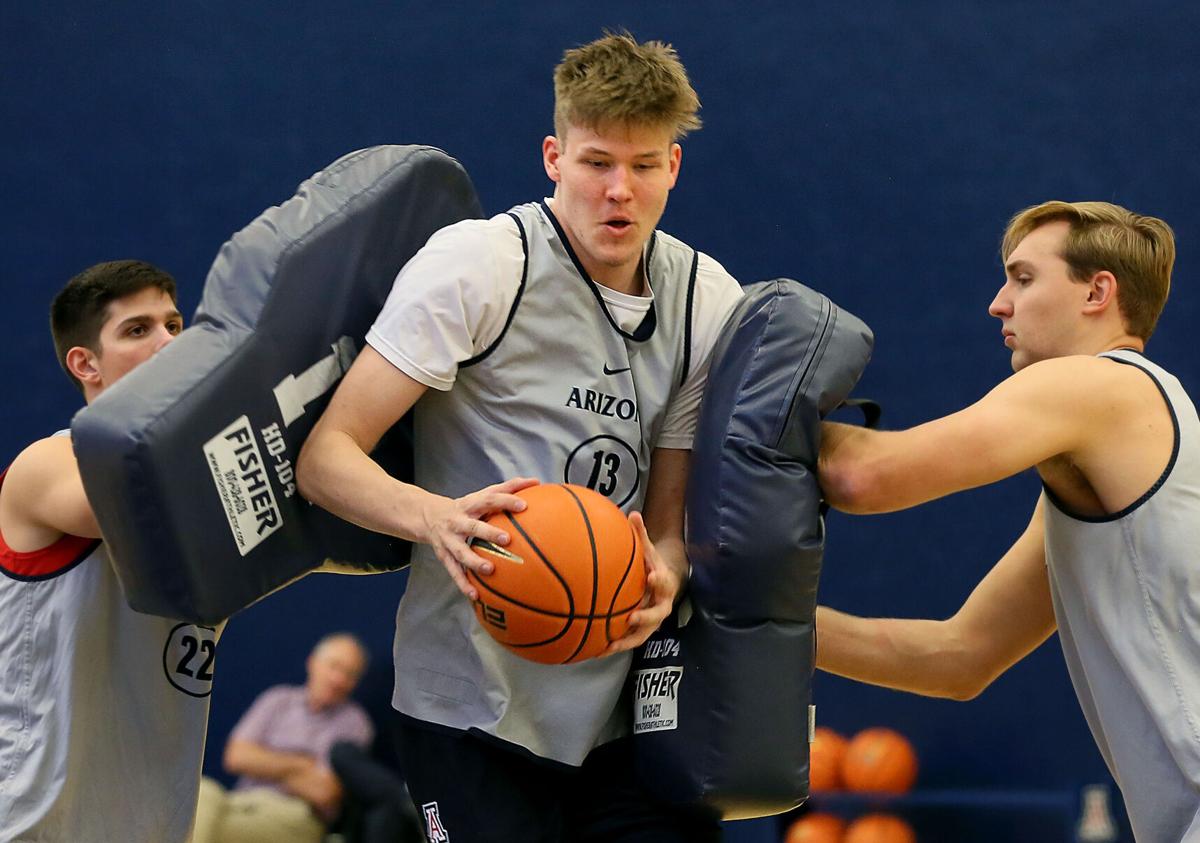As the Arizona Wildcats raced toward the end of their second preseason under Tommy Lloyd last week, a spirited version of the “charge drill” played out inside the Richard Jefferson Gym.
It looked something like this: Players took turns absorbing two blows of contact that sent them to the floor, hurriedly picked themselves up each time, then raced downcourt to dive on a loose ball — and tried to toss the ball upward from the ground into the hands of a trailing teammate for a quick basket.
Nearly every time, whether that final flip to their teammate failed or not, the player lying outstretched on the floor was smiling.
Exhausted and sore, maybe, but smiling.
“They should be,” Lloyd said afterward, smiling himself. “Listen, it’s a little bit of fun but it’s also trying to send a message.”
The message of “Tommy Ball” — have fun but be active, be aggressive, be resilient, be smart, be tough — came across clearly during nearly all of Lloyd’s surprising first season at Arizona.
The Wildcats finished 33-4, collected both the Pac-12 regular-season and tournament titles, earned a No. 1 NCAA Tournament seed and played so well and so far beyond expectations that Lloyd received multiple national coach of the year awards.
Except one thing was lacking at the end. The Wildcats needed overtime to escape tough, gritty TCU in the second round of the tournament and, when facing an even tougher team four days later in the Sweet 16, lost to Houston 72-60.
It turned out to be the same day that Lloyd’s friend and former boss, Gonzaga coach Mark Few, saw his similarly constructed team’s season end in a Sweet 16 game against Arkansas.
Gonzaga entered the tournament No. 1. Arizona was No. 2.
Both were gone before the Elite Eight.
“We talked, of course, and you’re always devastated and bummed out when you lose. We want to take every team as far as it can go,” Lloyd said. “But other than that, I think we also understand how hard it is to get to where both programs were.”
So maybe the end didn’t quite eat away at Lloyd all summer. But it wasn’t fun to chew on, either.
That’s why he set out, both in recruiting and coaching, to add a little more physical nature to the Wildcats. Already last season, Lloyd had his guys running the “charge drill” and other physical tasks in practices.
But the emphasis is different now.

Tommy Lloyd led Arizona to a Pac-12 championship and No. 1 seed in the NCAA Tournament during his first season in Tucson.
“There’s definitely more focus on it,” junior wing Pelle Larsson said. “In film, they’re always looking for someone to hit someone on a box-out and stuff like this.”
It helps that more guys know exactly what to do. A year ago, Tubelis noted that “we had no idea how to play in Coach Tommy’s system.” Now, half of the Wildcats’ 12 scholarship players return from a year ago — including four projected starters: Larsson, Tubelis, guard Kerr Kriisa and center Oumar Ballo.
And the fifth projected starter, grad transfer guard Courtney Ramey, just happened to play against TCU regularly while at Texas, as one of the Big 12’s best defensive players.
His “defense on the ball is, I mean, he’s a pest,” Larsson said. “I’m glad I’m on his team in practice, because he’s probably one of our best defenders.”
Ramey lit up when told that’s how Larsson described him.
“I like that. I’m gonna start using it — a pest,” Ramey said. “Me and him are doing a good job of feeding off each other, especially on the defensive end. We’re both aggressive defenders, with me coming from the league I came from, where it’s more physical.”
Larsson is probably the Wildcats’ top returning defender. As a sophomore transfer from Utah, the 6-foot-5-inch, 215-pound Swedish wing defended essentially every position except center, often taking on the difficult job of guarding the Pac-12’s many smaller, hybrid power forwards.
Last summer, while playing in just his second game with the Swedish national team, Larsson also picked up a large share of the defensive assignment on NBA all-star Luka Doncic.
So it will hardly be a surprise to see him be handed the responsibility of defending forwards such as UCLA’s Jaime Jaquez or Oregon’s Quincy Guerrier in Pac-12 play this season.

Kerr Kriisa helps Arizona Wildcats forward Henri Veesaar off the floor during Friday’s practice. Kriisa, a fiery junior from Estonia, is expected to run the point again this season.
“Have you stood next to Pelle?” Lloyd said last season, noting that Larsson was even considered for defending Illinois 7-footer Kofi Cockburn. “He’s as big as most people’s four-men, so I’ve got no problems putting him on anybody.”
A 6-6 grad transfer from Campbell, Cedric Henderson, Jr., is also capable of handling power forwards as something of a hybrid himself, able to play inside or outside. He also carries a veteran presence, being the 22-year-old son of a former NBA player.
The Wildcats’ big men, meanwhile, are a naturally tough obstacle, loaded with size, offensive talent and mobility. And, at least for Tubelis, with the motivation to be even tougher.
During the Wildcats’ shaky NCAA Tournament games against TCU and Houston, Tubelis totaled just seven points while shooting 2 for 14 from the field and averaging just 4.5 rebounds per game. That’s a pretty stark contract to the 13.9 points and 6.2 rebounds he averaged last season while becoming a first-team all-Pac-12 pick.
“I just need to be physical, go for rebounds, even more than last year,” Tubelis said. “When I watch film from last year, like, I didn’t go. I didn’t go for rebounds at all.”
In Ballo, the 17th-ranked Wildcats have a center not limited by physical strength — he’s 7-feet tall and 260 pounds — but more by stamina. Ballo improved as last season went on but still averaged 15.3 minutes per game.
Knowing he can likely earn as many minutes as he can stand this season without Koloko around, Ballo spent the summer working on his frame and endurance.
“I think he’s going to have a big impact at both ends of the floor,” Lloyd said. “I think the biggest area in his growth is just his belief in himself and in his work ethic.”
While Ballo is a capable scorer around the basket, the Wildcats also brought in two freshman bigs with the ability to stretch a little offensively: 6-10 Henri Veesaar of Estonia and the 7-foot Dylan Anderson of Perry High School in Gilbert.
Together, the big men suggested in the Red-Blue Game that the Wildcats might want to run a lot of their offense through the inside. Ballo and Veesaar each scored 16 points, while Anderson added 10 points and seven rebounds.
All of them also handled the ball extensively, though that led to 10 turnovers between Ballo, Anderson and Veesaar.
“That’s what allows us to move the ball the way we do, and we’ve just got to work out the kinks there,” Lloyd said. “I think these four are going to be a formidable force.”
On the wing, the Wildcats also have a pair of promising 18-year-olds in Europeans Adama Bal and Filip Borovicanin.
Now a sophomore, Bal showed flashes of talent as a young freshmen last season, while Borovicanin as a freshman this season is a a big wing shooter who is expected to take time to grow into a bigger offensive role.
In the backcourt, freshman Kylan Boswell has a natural physicality to him, with 195 pounds on his 6-2 frame, but also offensive skills that can place him at either guard spot.
Then, at point guard, there’s the fiery Kriisa, the guy who literally jumped on the college basketball scene when he first became eligible late in the 2020-21 season, leaping in front of all-league guard McKinley Wright of Colorado to take a charge. He’s also the guy who found himself talking smack to Doncic while playing for Estonia in a World Cup qualifying game last August.
Iif Kriisa pulls the same sort of fearless moves this year, the rest of the Wildcats just follow suit.
If so, then, maybe facing the Houstons and the TCUs of college basketball might not be such a problem for the Wildcats anymore.
“I think we always want to be physical,” Lloyd said. “I think we were physical last year. It’s just at the end, we played the most physical team. I’ve never really felt that we were soft. I just wanted it to become a staple of who we are.”







